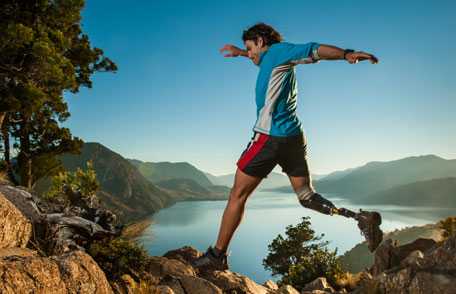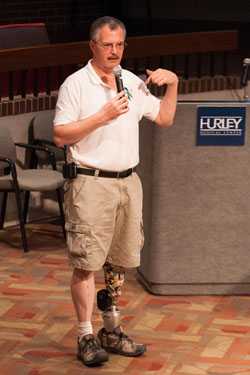International Day of Persons with Disabilities
 Over one billion people, or approximately 15 percent of the world’s population, live with a disability.1 Learn how technology can help improve the well-being and inclusion of people with disabilities in every aspect of life.
Over one billion people, or approximately 15 percent of the world’s population, live with a disability.1 Learn how technology can help improve the well-being and inclusion of people with disabilities in every aspect of life.
In the United States, and around the world, people with disabilities face physical, social, economic and attitudinal barriers2 that prevent them from learning, living, working, and playing in their communities. December 3rd is International Day of Persons with Disabilities. This year's theme is "Sustainable Development: The Promise of Technology." You can use this day to promote the impact and benefits of technology that improves the health and well-being of people with disabilities.3
Dave's story
Dave can attest that technology can be a great thing for persons who have lost a limb. As a result of an accident as an on-call firefighter, Dave broke his leg (both his tibia and fibula bones). "During surgery it became infected," he says. "After 21 surgeries over a 4-year period, I made the decision to amputate."
Initially Dave was fitted with a prosthesis (device designed to replace a missing part of the body) that did not have any movement in the ankle. "It basically was like walking with a two-by-four strapped to the bottom of my foot and around my ankle," says Dave. Although it got him up and walking, it was very difficult to use and by the end of the day he was exhausted and ready to crawl into bed.

Using his technologically-advanced prosthesis, Dave walked 57 miles of rough terrain with his son.
He now uses one of the most technologically advanced prosthetic devices in the world which saves him energy and effort. For example, the device can propel him forward and up and down stairs. It has assisted him far better than any other device he has tried. Now he can walk around, without getting tired, and in 2012 he joined his son on a Boy Scout High Adventure and covered 57 miles of rough terrains in five days. These are the kinds of things he is able to do now with his new prosthesis.
Dave doesn't think limb loss limits someone's capabilities or goals, rather he explains that he is simply "differently-abled." A person can return to a normal level of activity and more when he or she has the correct prosthetist (a person who measures, designs, fabricates, fits, or services a prosthesis), and prosthetic equipment. Dave believes that "finding a good prosthetist is like hiring an employee" and suggests others to 1) visit as many prosthetists as you can and 2) take your prosthetist a list of all the things you want to get back to doing.
CDC would like to thank Dave and the Amputee Coalition for sharing this personal story.
Learn more about the Amputee Coalition.
Types of assistive technology available for people with disabilities:
- Devices or equipment, such as wheelchairs, hearing aids, magnifying glasses, prosthesis, that can be used to help a person with a disability fully engage in life activities
- Accessible information and communications technology that is available for people with functional limitations, such as those with difficulties seeing, hearing or concentrating, remembering or making decisions.
- Technological adaptations that make an inaccessible general use device usable by a person with a disability.
- Policies and programs that aim to make different kinds of technologies for people with disabilities more available, more useful and more affordable. For Example, the Assistive Technology Act, and the Rehabilitation Engineering and Assistive Technology Society of North America (RESNA).
What CDC and our National Programs are Doing
CDC provides technical support and funding for the Amputee Coalition National Limb Loss Resource Center, which offers information for people with limb loss, their families, friends, and the healthcare professionals involved in their lives. The resource center is one of four National Public Health Practice and Resource Centers supported and funded by CDC to improve the quality of life for people living with disabilities.
The goal of the Amputee Coalition National Limb Loss Resource Center is to give accurate and timely information to people who need to understand and resolve issues about their healthcare. With the help of these resources, they can choose the best available options, discuss these options with their healthcare providers and caregivers, and plan for their future.
Disability Resources at CDC
Being healthy means the same thing for all of us—staying well so we can lead full, active lives. Having the tools and information to make healthy choices and knowing how to prevent illness is key to being well, with or without a disability.
Visit these resources to learn more:
- Personal stories from people living with a disability
- Healthy living
- Emergency preparedness
- Disability and Health Data System (DHDS)
- CDC Disability and Health
- CDC National Center on Birth Defects and Developmental Disabilities
As we honor International Day of Persons with Disabilities, we ask you to join us in being a part of the global disability movement to change attitudes and approaches to disability and promote the equity and full inclusion of people with disabilities in society and across public health activities.
Resources
References
- Disability. The World Bank.
- World Report on Disabilities 2011. World Health Organization.
- International Day of Persons with Disabilities, 3 December 2014. United Nations Enable.
- Page last reviewed: December 1, 2014
- Page last updated: December 1, 2014
- Content source:
- National Center on Birth Defects and Developmental Disabilities, Division of Human Development and Disability
- Page maintained by: Office of the Associate Director for Communication, Digital Media Branch, Division of Public Affairs




 ShareCompartir
ShareCompartir